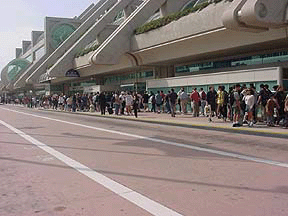Overview of the San Diego Comic Con 2000
by Chuck Rozanski
|
We're all back from the giant San Diego comics convention, and I'm still so excited that I don't even know where to begin. This year's convention was the most optimistic and uplifting comics convention that I have ever attended. The energy that permeated the atmosphere of the con was even more positive than the exciting days of the early 1990's, when the comics world seemed to be on fire, and the whole rest of the world was suddenly taking comics seriously. What brought about this change? Well, the X-MEN movie helped a lot. The fact that it has been a box-office hit was a great boost for the comics industry. Marvel finally had a film produced about is characters that wasn't a dog (not to disrespect BLADE, which was actually a better film, but got far too little acclaim...). What helped even more, however, was the publicity about the film. The spin the creators were putting on the film during interviews was that X-MEN was a comics title for adults. A complex storyline of interweaving characters that was written for comics fans of all ages to enjoy. The film mirrored that position, with a decent story and well-established characters. Better yet, unlike most film creators (such as Tim Burton...) the producers were not interested in making a movie about comics characters, but rather they sought to make a film that mirrored the dynamics of reading a comic. X-MEN is constructed exactly like a traditional comic book, and leaves off at the end with plenty of room for a continuing story. I'm so glad to know that all the actors were signed for a three-film contract! The X-MEN movie was not, however, what made the San Diego convention great. I think the dynamics of success at the con were set into place long before the film ever released. Thanks to having a great team of people from Denver with me at the convention this year, I was able to spend a great deal of time analyzing the motivations of attendees at the convention. This means I got to do things such as stand completely still in the middle of the main aisle of the convention on Saturday at 2 PM, and spend half an hour eavesdropping on the waves of people who passed by me. What I heard over and over again, interspersed in the excited chatter about comics, or manga, or film, was Internet and e-mail. Repeatedly there were statements like "I'll see you in cyberspace," or "I'll e-mail you when I get home..." What makes this remarkable to me is that it completely contravenes my original theory of what the Internet was going to do to conventions. Logically spoken, since fans can now find more products online than they could ever find at any single event, it argues that conventions would go into decline. Why pay travel costs, and $60 to get into a convention, when you can now find more cool stuff than you could ever buy online? The answer is simple: human contact. People are social creatures, and they take great effort to gain the psychic reinforcement of meeting and interacting with people who share similar interests. Simply put, if you collect SPIDER-MAN comics alone in your basement, you feel like a geek. But if you're part of a huge Internet group that collects SPIDER-MAN, and you can meet up with these similarly-inclined people once a year at San Diego for a party, suddenly you feel hip and cool. Simplistic, but true. San Diego has changed into a gathering of the clans. Internet pen-pals from all of the world coming together to play with each other. Not everyone at the convention shares the same interests. Far from it. With over 50,000 attendees you had fans in every sub-set you could imagine. But one major overriding theme that I felt stimulated this year's convention was the desire for personal interaction between people who only knew each other online. Another very significant element that led to the success of the convention was the immense effort the convention committee puts into making the convention available to the people of San Diego. Denver has a large convention center, and they host many conventions with over 50,000 attendees. Yet, no one ever hears about them. That is absolutely not true in San Diego. The entire Comic-Con staff, many of them volunteers, have worked for decades to make comics socially acceptable in San Diego. This year I saw that succeed in a way that I thought was quite wonderful. The teen-age girls came! For the first time in my memory I saw lots (I mean lots!) of unaccompanied teen-age girls wandering the halls. They were not there because their boyfriend dragged them in, but they were there because they perceived of comics (and the entire entertainment culture of the convention) as being a hip place to be. I even overheard one young woman telling her friends that she rode the Amtrac, alone, all the way from Hollywood because her friends, and her boyfriend, were not into comics. That NEVER happened before! We're now managing to reach an audience (or several audiences, as the convention also drew in a very large number of families with small children) that never before perceived of comics as socially, artistically, or culturally acceptable. All of these factors put together made the convention a fascinating study in the rebirth of an industry. The trade show (Wednesday - dealers and publishers only) was better attended than last year, but still quite light. The mood on Wednesday was cautiously optimistic, which is basically where we've all been at for the last year. Many good things were perceive of happening, but everyone knew that there was still a steady erosion in the number of comics retail stores. Without easy access to comics, we knew that it was going to be a tough road to keep comics fans buying. By Thursday night, everyone in the dealers room knew that we were experiencing a watershed event in the history of comics. Not only was the attendance immense on Thursday, but fans were buying like crazy! Everyone I spoke to was having a great con, and a couple of dealers told me that they sold more items on Thursday, than they did in the entire four days of the convention last year! More importantly, no one was talking "investments" (except for the Golden Age crowd - they never change...). Everyone was buying their comics, or other items, for entertainment. Not to gamble in some perceived future value game. That's such a refreshing change! During the last boom in comics (1989 - 1993) the overriding desire of most purchasers was investment. Now it's genuine demand, and I think this bodes very well for the future of the industry.
Another factor I think is very encouraging is the vitality of the new comics
business. In writing this month's column I was struck by the incredible
spectrum of diversity in offerings from the publishers. There are no huge
projects this month (with the possible exception of the new Marvel
crossover series), but there are sure plenty of cool comics, toys, and
books on the horizon. I made a special point this month of adding every
number one issue to my list of recommended items, and to also touch upon
certain areas (such as the SUPERMAN titles) that are quickly gaining
momentum. That makes my column very long. That is a far better alternative,
however, to those months in the not too distant past when I wondered if we'd
ever see publishers soliciting a full line of publications again. Enjoy!
Chuck Rozanski,
|
[San Diego Comic Con Report #3] [San Diego Comic Con Report #4] [San Diego Comic Con Report #5]
[San Diego Comic Con Collection]


